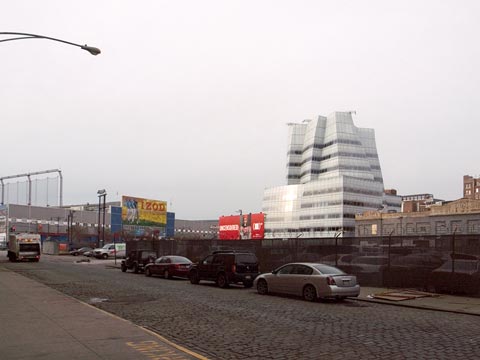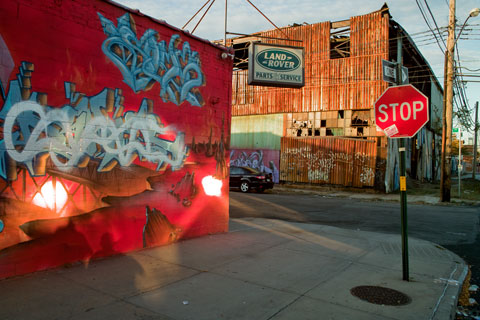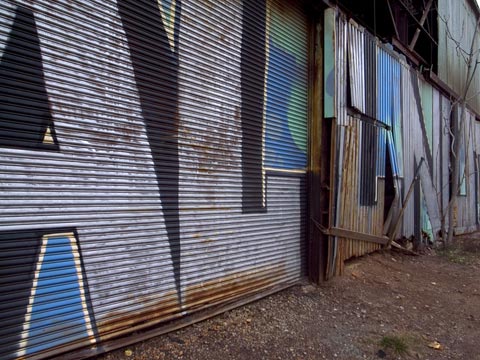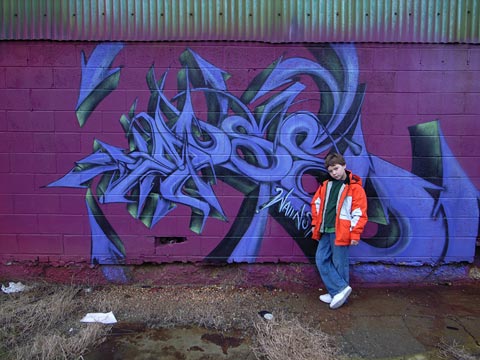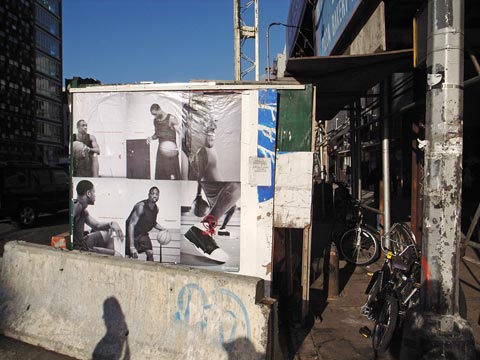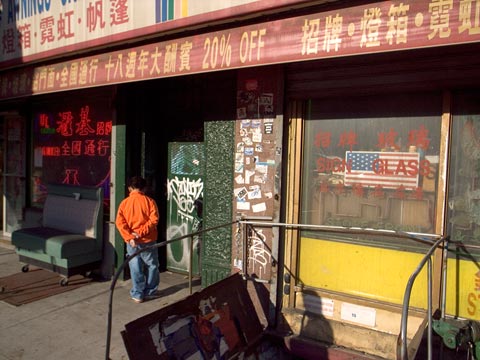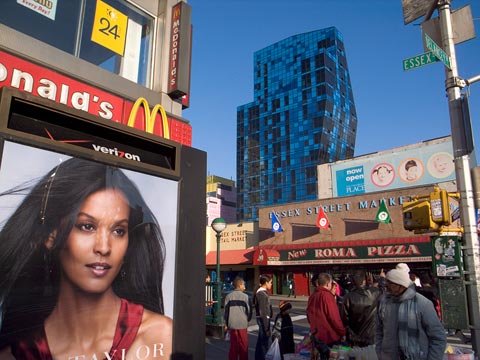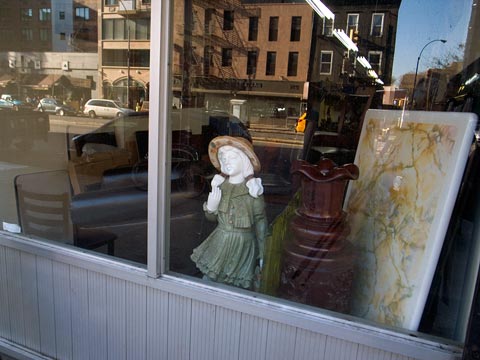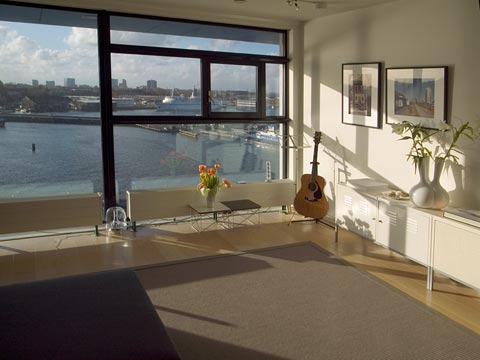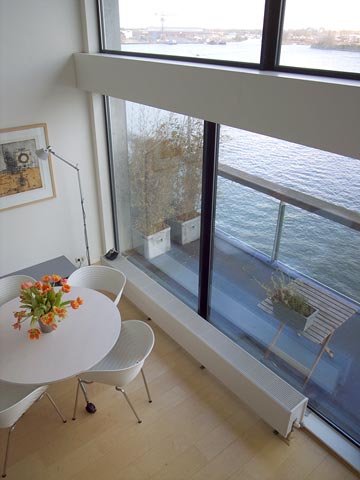Walking downtown through Chelsea–the Frank Gehry IAC building momentarily stands alone above the Highline rail viaduct and vacant lots. This is an area destined to change radically in the next few years. The Highline, which is being developed as an elevated slender ribbon of park (and other amenities) will be, if I may go out on a limb, the single most notable legacy of Mayor Bloomberg’s adminstration.
New York/LES
I’ve been going through the negatives of my Lower East Side work, scanning promising images, and in general, trying to get a handle on where the project is at the moment. There are a lot of negatives. Some of the photographs show specific places or point to the changes occuring in the neighborhood. But others, like the picture above, are more about the feel and flow of the street.
Working with the view camera there is a tendency to overcontrol the frame–every line or patch of color is located precisely–and as a result the images can become static, emptied out of vitality. One way I attempt to keep things loose is to allow random movement within the frame, whether it’s people walking, cars passing through, or simply the quiver of leaves in the wind.
Although the Lower East Side is a busy place with lots of people on the street, if you stop everything for a 1/15 of a second, the scene can appear rather empty. In real time, the flow of people is constant, and twenty people may go by in a few seconds, but in still photography time it may be two individuals, or none at all.
With a small camera it’s possible to move with that flow of people and shoot rapidly. With the view camera I necessarily set up the frame and then let things happen within it. I wait rather than chase. What I strive for is the feel of spontaneity while still keeping a tight grip on composition and framing. I’d like the photographs to have some of the spirit of small camera photography while at the same time containing the consideration of detail that is only possible with the view camera.
New York/Queens
Rainy day in New York. We’re finally getting settled in after the move. Made a little excursion to the Noguchi Museum in Queens. Pizza for lunch. R train and a walk on Broadway–not the Great White Way–the one in Astoria.

On the way to the Noguchi Museum
We went to both Socrates Sculpture Park and the Noguchi Museum. The park is a somewhat ragged, but cool landscape dotted with outdoor art, originally created by Mark di Suvero, a master of steel sculpture. The Noguchi Museum is nearby occupying a brick factory building and a modern annex. It’s a totally unassuming structure, almost invisible, among a motley collection of sheds and warehouses, many covered with grafitti. Within the museum, the city disappears, and one is immersed in the world of one of the great sculptors of the 20th century. It is well-worth the trip out of Manhattan. Unfortunately, I forgot to take pictures while in the museum.
New York/Essex Street
A couple of months ago I posted a digital image of Essex and Delancey Streets on the Lower East Side of Manhattan. Here is the 4×5 version, shrunk down and low-rez for the web, of course. This image and the following text is also on my homepage in the Outtakes section.
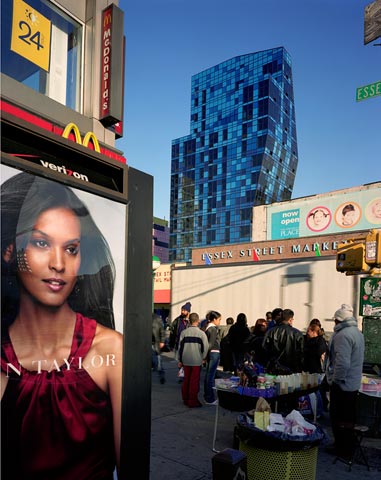
Essex and Delancey Streets (4×5 negative)
Rising out of the tumult of the Lower East Side amid the discount stores of Delancey Street is Blue, a condominum designed by architect Bernard Tschumi.
For the moment, sneaker shops and fast food hold sway–but for how long? The icy blue-on- blue, glass-against-sky, tower looms above the riff-raff and roaring traffic of the Williamsburg Bridge.
As I continue to photograph the Lower East Side, I return to such architectural icons, unthinkable just a few years ago, as touchstones of New York’s present gilded age.
New York/Iconography
Running around town doing errands I snapped a picture of the ubiquitous hawkers of images and icons of New York. In this case, the Statue of Liberty against an American flag, Bow Bridge in Central Park with its backdrop of apartment buildings, the Brooklyn Bridge with the Twin Towers forever etched in the sky, and the Imagine mosaic in Central Park dedicated to the memory of John Lennon. The latter two depict relatively recent tragic events that have transformed the collective iconography of the city.
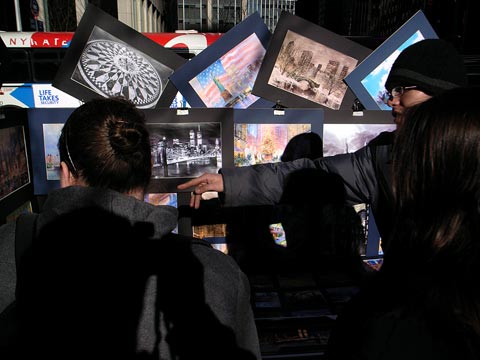
Sixth Avenue, Rockefeller Center
Architect Santiago Calatrava who has designed the PATH station soon to be built on a part of ground zero said this:
New York, in my eyes, was a young, very vital city. But suddenly with Sept. 11, after an enormous tragedy happens, things change. Suddenly New York is no longer a young city. It plays in another league now, like Athens, Rome, Jerusalem. A city that has been burned down and rebuilt. New York now has this depth. It is not the same thing to build here as it was before. It is like building in Jerusalem.
Fortune, 8 November 2006
Interview with Julie Schlosser
Amsterdam/New York
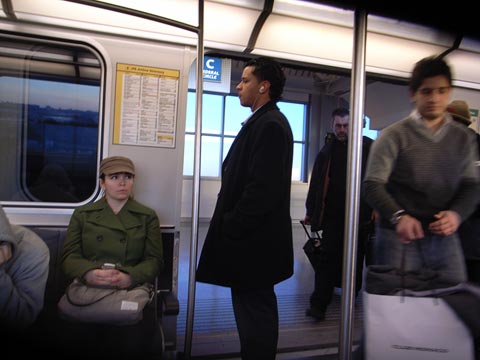
Airtrain, JFK Airport
Life in transition. I’m back after several weeks of making the move from Amsterdam to New York. We are still eating on a cardboard box, but have generally made a successful landing in a beautiful apartment in the West Village near the Hudson River. For me, it’s less of a momentous move than for my wife Renée and son Brendan. After all, I’ve been commuting back and forth between Amsterdam and NYC for a long time. For all of us it’s an opportunity for a fresh start with new career and life opportunities. And I should now be able to pursue my art projects and architectural photography without the constant interruptions and dislocations of the past 10 years. I also hope to renew my ties with the New York songwriting scene that I used to be an active part of. So, stay tuned for lots more reports here and about town in 2007.
Amsterdam
Back in Amsterdam. Busy packing and taking care of a million things to make our move to New York. As most of you know I’ve been commuting back and forth for a number of years. That will finally come to an end in January. In the meantime, journal posts may be somewhat sparser than usual.
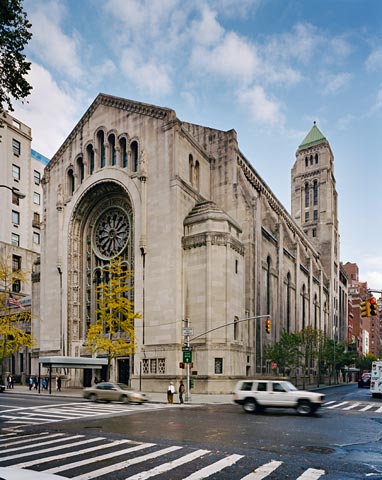
Temple Emanu-El, New York
I’ve uploaded a web page of my Temple Emanu-El photos.
New York/Rodger Kingston
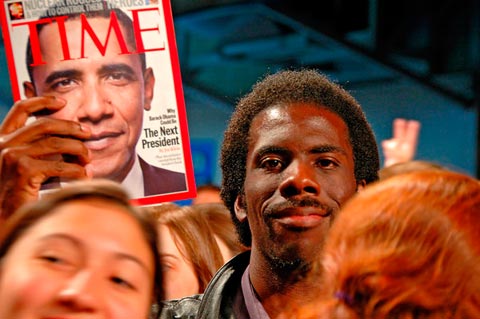
Photo by Rodger Kingston
I met Rodger not too long ago–a terrific photographer and Walker Evans scholar. Recently he volunteered his eye and digital camera to the Deval Patrick gubernatorial campaign in Massachusetts. Rodger photographed various public events, covering the speakers and notables like Barak Obama admirably, but his best moments were when he turned his camera away from the podium and interacted with the crowd. I say interacted because Rodger was both documenter and participant in the unfolding drama of the campaign, which culminated in Patrick’s victory. Go here.
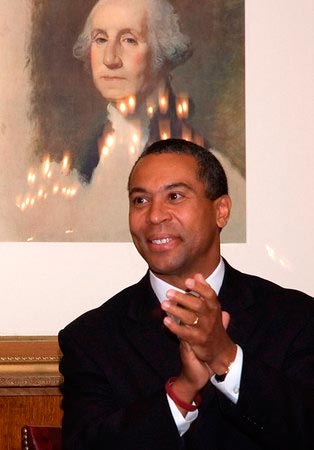
Deval Patrick, photo by Rodger Kingston
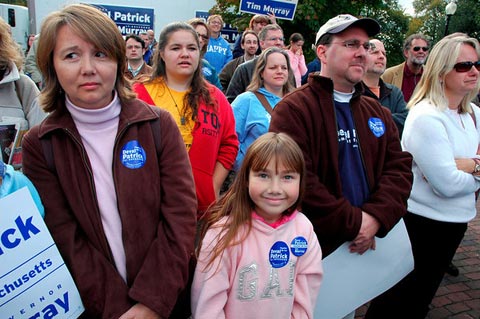
Photo by Rodger Kingston
New York/Midtown
I spent two days on the 50th and 51st floors of a Midtown office building photographing the executive suite of a large international bank. Great views on all sides. Looking northwest, and standing amid a forest of mostly mediocre skyscrapers, is Norman Foster’s newly completed Hearst Tower. It’s the one with the diagonal bracing. For more information and photos go here.
New York/Apartment Hunt
I haven’t posted much lately because I’ve been hoofing it all over lower Manhattan looking for an apartment for my family. It’s been an incredibly frustrating experience. It’s not just that prices are high–that was a given–but that there’s so little available for rent at any price. One loft in Tribeca that I loved was snatched from under me by someone with a blazing checkbook. I’ve been using several brokers, a New York necessary evil, who have been very nice and have tried to find me a suitable place. So far, they, and I, have failed. But earlier today I applied, without a broker, for a loft in a building in the West Village near PS 3, a school that would be great for my son Brendan.
Hopefully, I will snag this one.
Walking back to my East Side apartment I passed by Moss, a terrific design store on Houston Street.
New York/Photo Galleries
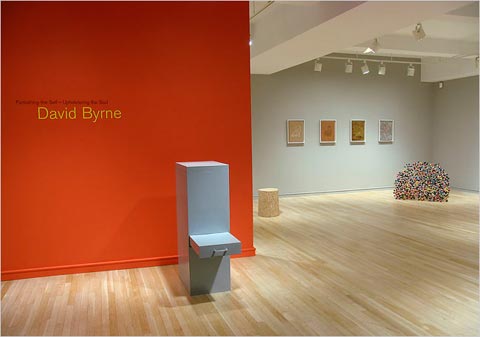
David Byrne not exhibiting photographs at Pace/MacGill, New York Times
I don’t know quite what to make of today’s New York Times article about photography galleries. Philip Gefter alerts us that traditional photo galleries are now occasionally showing other media. He writes:
It may not be a revolution, but it is a significant change in the gallery landscape. These are the places that helped to establish photography’s viability as an art form as well as to create a business model. Having proven their point, they are now at liberty to experiment.
When I came to New York in the late ’70s, photography was relegated to a group of galleries that exclusively exhibited photographic prints. The most prominent at the time was Light Gallery, which did much to elevate the status of photograhy in the art world. John Szarkowski at the Museum of Modern Art did even more by showing photographs in the context of the canon of 20th century art. MoMA’s photo galleries may have been separate, as they are now, but the prominent inclusion of photography in the museum signalled the arrival of the medium under the big top. Even so, the promiment art galleries in New York mostly showed photographs by artists known for other things. Warhol and Hockney are two obvious examples. I remember well when Jan Groover was exhibited at a mainstream art gallery on West Broadway back when the scene was still centered in Soho. This was a big deal to me because I saw her work as intrinsically photographic–4×5 still lifes of kitchen utensils–printed on conventional photo paper. She had broken through the photo/art Iron Curtain.
Eventually photography became an equal player, though as a print medium there are different market forces at work. The galleries–and the photographers–have tried to enhance the value of photographs by making them bigger or by creating work that pushes the envelope of what is thought of as conventional photography. Think Cindy Sherman or Andreas Gursky. But I think one of main reasons for the continued existence of separate photography galleries is that they cater to a different set of collectors. Nowadays there’s some overlap among the collectors, hence some overlap in the galleries as well. Will the boundaries blur further? Maybe, maybe not. Does it matter?
Anyway,the phenomenon is worth noting, I suppose, but I’d rather have read a perceptive article about Esko Mannikko’s exhibit at Yancey Ricardson. A photo of the gallery illustrates the NYT article and is captioned as photographs with a nonphotographic look. Mmm. And, by the way, the Times misspelled his name.
New York/Bowery/Delancey
New York/Bowery
Walking down the Bowery one comes across all kinds of stuff displayed on the streets. Between Houston and Delancey it’s the restaurant supply business with stainless steel cooking equipment being cleaned on the sidewalk, bulky pizza ovens and refrigerator units hoisted by forklifts on and off trucks. Chairs and bar stools are stacked in front of storefronts, and even decorating bric-a-brac is available. The way things are going, however, this raw working Bowery is doomed.
As usual, I am working with the 4×5 view camera, and these images were made with a small digital camera to preview what I’m doing and encourage a somewhat different way of looking at things.
New York/LES
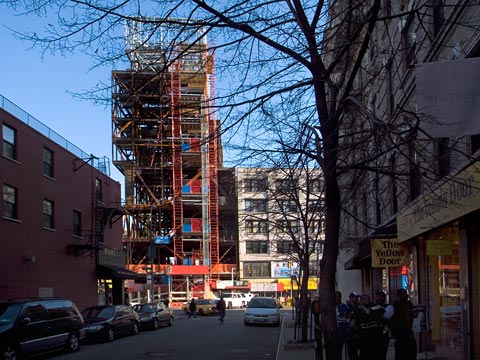
The New Museum under construction on the Bowery
Back in New York after a less than smooth re-entry. I forgot my keys and cell phone, and by a miracle was able to get my assistant Chris to meet me at my apartment with his set of extra keys. The weather has been beautiful since arriving, and I got out with my camera for another walk through the Lower East Side. I began close by on the Bowery. More pictures to come…
Amsterdam/New York
There are a number of things I will miss leaving Amsterdam, but none more than this apartment in the building called the Silodam, which was designed by the Dutch architects MVRDV. It sits on an earthen pier, also called the Silodam, projecting out into the Amsterdam harbor.
Pictures of the building here.
Amsterdam/Sunrise

The Ij (Amsterdam harbor) at sunrise
Robert Altman, the filmmaker died today. Ever since I began seriously pursuing photography I’ve been greatly influenced by movies–perhaps just as much as by still photography–and Altman is one of the American directors I’ve most admired. I can’t remember what movie of his I saw first. It could have been M*A*S*H or McCabe and Mrs. Miller. The latter featured the songs of Leonard Cohen, another artist who I greatly admire. It was Nashville, however, that really captivated me stylistically with characters moving in and out of frame, overlapping dialogue, and crisscrossing storylines. Later on, I was terribly enamored of Shortcuts, his adaptation of Raymond Carver short stories, a seemingly impossible task. Like Nashville it weaves together stories that are otherwise seemingly disconnected. Although my photography is not so much about people’s narratives, Altman’s landscape of random juxtapositons is the same one I wander across with my camera.
Amsterdam/Sinterklaas
If all goes according to plan we will be leaving the Netherlands in a month and a half. Since 1993 I have been flying back and forth between Amsterdam and New York, all the while trying to maintain both a fine art and professional architectural photography career. It has not been easy.
In the beginning the Netherlands offered a fresh start, a new relationship, and a chance to broaden my horizons. As a transplanted New Yorker, however, I found my new home baffling, contradictory, and most definitely not the progressive land of tolerance so widely touted around the world. To explain this conclusion requires going through a litany of complaints, mostly trivial, but cumulatively overwhelming. I won’t do that now.
It’s getting late in November and the days are growing short, the sun is low in the sky when it does show itself in this mostly dreary climate. It’s almost time for Sinterklaas to arrive on his steamboat from Spain accompanied by his Black Petes. The Dutch cling tenaciously to the iconography of Sinterklaas: the severe bearded man dressed in Catholic bishop’s attire, the black-faced afro-wigged Petes cavorting about. It’s a children’s thing, but it is promoted with what seems an almost manic enthusiasm by adults. To outsiders interlopers like me who cannot get past the racist imagery of Black Pete, the whole business is repellent–and in bad taste. It is cultural heritage as kitsch–not a uniquely Dutch phenomenon, of course–but especially egregious.
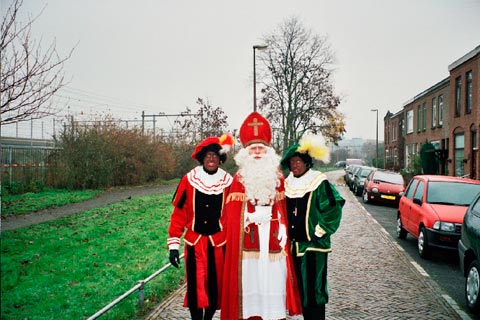
Sinterklaas and Black Petes (not my photograph)
Amsterdam/NYC Ticker Tape Aftermath

Trinity Church Yard, 1981 (4×5 film)
I’m in Amsterdam, but my thoughts these days are across the Atlantic.
On January 25, 1981, 52 Americans who had been held hostage in Iran for 444 days returned to the United States. New York City Mayor Edward Koch invited them all to a ticker-tape parade in Manhattan, offering them free hotel rooms and airfare for two. On January 30, approximately two million New Yorkers turned out to welcome them home. Twenty-three former hostages took part in the parade. They traveled in open cars up Broadway from Battery Park to City Hall, where Koch welcomed them and presented them with the keys to the city and the City Council’s Proud City Award. The Sanitation Department estimated that 971 tons of paper were thrown.
–Cynthia Blair, Newsday
